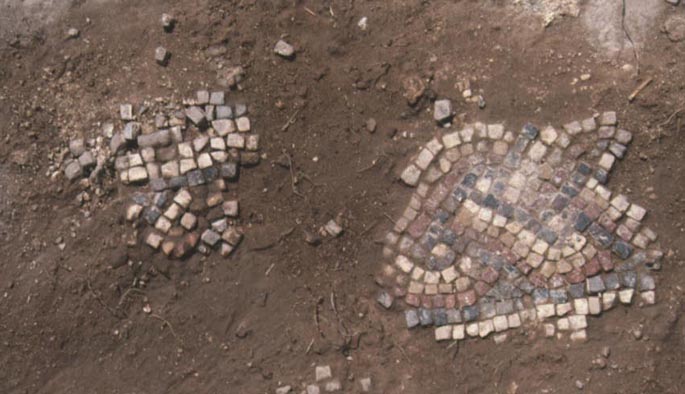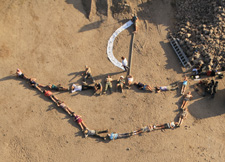Area D2

Above the southern bay and the remains of an ancient well and ancient quays excavated by A. Raban in 1979 - 1984, dated by him to the Late Bronze - Iron Age 2 range.
Recent Investigations
Stratigraphic sequence
Roman Period
Local phases 1-2: Two phases of house remains, comprising parts of three insulae, criss-crossed by two streets - the southernmost E-W street, and the main N-S street, the cardo which bisects the town, leading from the southern harbor to area G.
 One insula (the southwestern one) seems to be occupied by elegant
residences, some with mosaic floors.
In the northeast insula (the main excavation area), a residential
structure seems to be replaced by a larger, more public one. The third
insula (the southeastern one) has
industrial installations of indeterminate use.
One insula (the southwestern one) seems to be occupied by elegant
residences, some with mosaic floors.
In the northeast insula (the main excavation area), a residential
structure seems to be replaced by a larger, more public one. The third
insula (the southeastern one) has
industrial installations of indeterminate use.
Hellenistic - Persian Periods
Local phases 3-5: The basic divisions (insulae and streets) are similar to the subsequent Roman period. However, there is a marked change in the character/function of the area within this period: in the Persian period mostly buildings comprising long and narrow halls are attested, probably harbor store-houses. During the Hellenistic Period, the are becomes residential. In the northern edge of a the northern insula a building of massive, perhaps even palatial proportions is beginning to appear, which continues in the adjacent area D1.
Iron Age 2b-c
 Local phases 6-7:
Most of the area was open space during these phases. In phase 6 this space was used
for industrial activities. Piles of industrial wastes contain evidence for Iron
processing and shards of many hundreds of Assyrian-period storage containers. In phase
7 the center of the area comprised of a large plastered courtyard, but at the edges
corners of two large public structures appear: The 'monumental building'
(see below)
on the southeast quadrant of the area may have still been in use, in its last phase,
in this period. The wall of another building - constructed of monumental ashlar blocks,
appears in the northwestern corner of the area.
Local phases 6-7:
Most of the area was open space during these phases. In phase 6 this space was used
for industrial activities. Piles of industrial wastes contain evidence for Iron
processing and shards of many hundreds of Assyrian-period storage containers. In phase
7 the center of the area comprised of a large plastered courtyard, but at the edges
corners of two large public structures appear: The 'monumental building'
(see below)
on the southeast quadrant of the area may have still been in use, in its last phase,
in this period. The wall of another building - constructed of monumental ashlar blocks,
appears in the northwestern corner of the area.
Iron Age 2a and the Iron Age 1|2 transition
Local phase 8: The area can be divided up to several building complexes:
The SE quadrant is occupied by a monumental structure built of
large boulders with ashlar construction in its corner. This building may
have originally been as large as 20 x 40 m. or more, but only 10 x 10 have
thus far been excavated. Several reconstructions and many floor levels were
noted, spanning the Iron Age 1b (see below) to 2a, and perhaps also 2B (above).
Along the western edge of the area is another massive structure - so far known only
by its eastern wall, also built of boulders. This wall appears to curve around the
natural kurkar ridge that has its edge here, earning it its nicknames 'the bastion'
or 'the acropolis' wall. The 'bastion' is connected to the 'monumental building'
by yet-another boulder wall - the 'sea wall' which forms the southern edge of the
excavation area.
 The space between 'the bastion' and 'the monumental building' was used in phase 8
for a more modestly built house (nicknamed 'Benni's house)on the north.
The center of the area was a courtyard framed by 'Benni's house' on the north, the
'bastion wall' on the west, the 'sea wall' on the south and the 'monumental
building' on the east.
The space between 'the bastion' and 'the monumental building' was used in phase 8
for a more modestly built house (nicknamed 'Benni's house)on the north.
The center of the area was a courtyard framed by 'Benni's house' on the north, the
'bastion wall' on the west, the 'sea wall' on the south and the 'monumental
building' on the east.
'Benni's house' collapsed and was rebuilt several times, and the adjacent courtyard was raised and repaved with each rebuild. These rebuildings and resurfaces, and their associated assemblages, mark the gradual transition from the Early Iron Age to Iron Age 2a.
Some of the important finds, such as a hoard of silver tokens - one of the first markers of pre-monetary economy, and some of the earliest Greek pottery in the Levant were buried under the successive surfaces of the courtyard.
Iron Age 1b
 Following an intermediate phase (11) are local phases 9-10:
The 'monumental building', 'bastion' and 'sea wall'(see above) were all built in
local phase 10. This phase and the subsequent one (9) exhibiting the material culture
of the late Iron Age 1 (Ir1b in Dor terminology) - including the
earliest 'Phoenician Bichrome' wares and the
earliest Cypriot (Cypro-Geometric IA) imports.
Following an intermediate phase (11) are local phases 9-10:
The 'monumental building', 'bastion' and 'sea wall'(see above) were all built in
local phase 10. This phase and the subsequent one (9) exhibiting the material culture
of the late Iron Age 1 (Ir1b in Dor terminology) - including the
earliest 'Phoenician Bichrome' wares and the
earliest Cypriot (Cypro-Geometric IA) imports.
The main structure of this horizon was found beneath 'Benni's house' of phase 8 and the courtyard. It is a mudbrick storage facility, consisting of long narrow halls. This structure abuts the 'bastion' and 'sea wall' but is separated from the 'monumental building' by a wide slab-covered drainage channel.
The Iron Age 1a|1b transition and Iron Age 1a
Local phases 12 - 14: are several successive strata between bedrock and the monumental constructions of the Iron Age 1b. They feature a wide wall built of small fieldstones, parallel to the seashore (the earliest precursor of the 'sea wall'?) and several phases of construction, also in small fieldstones ('Nati's house'), abutting it. The earliest remains of ancient quays - a massive pavement of flat stones sloping into the southern bay, may date to these phases.
